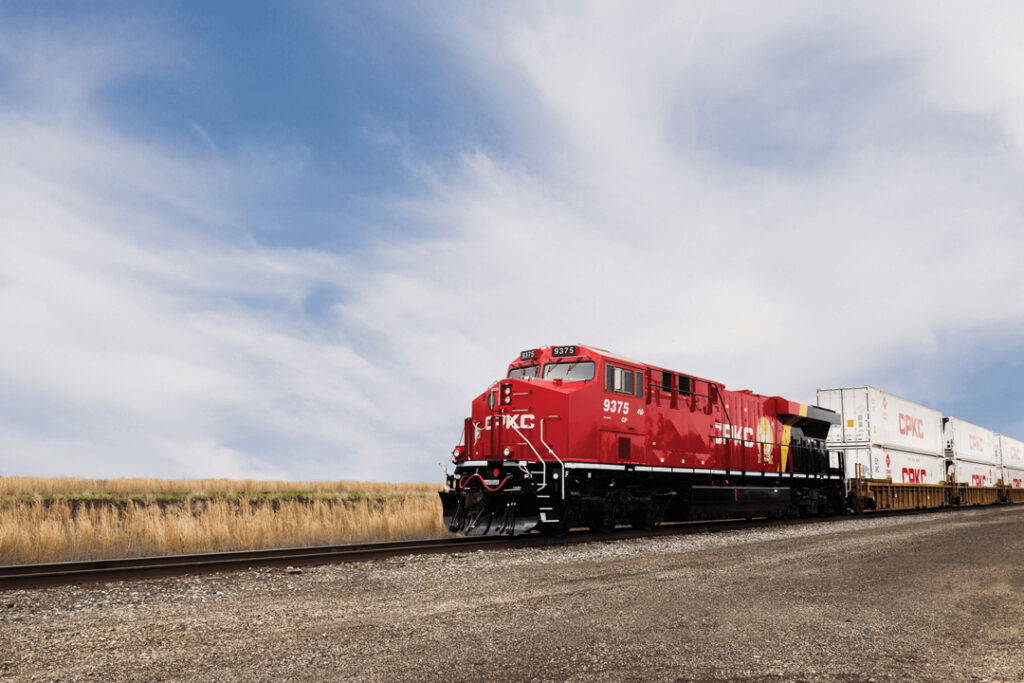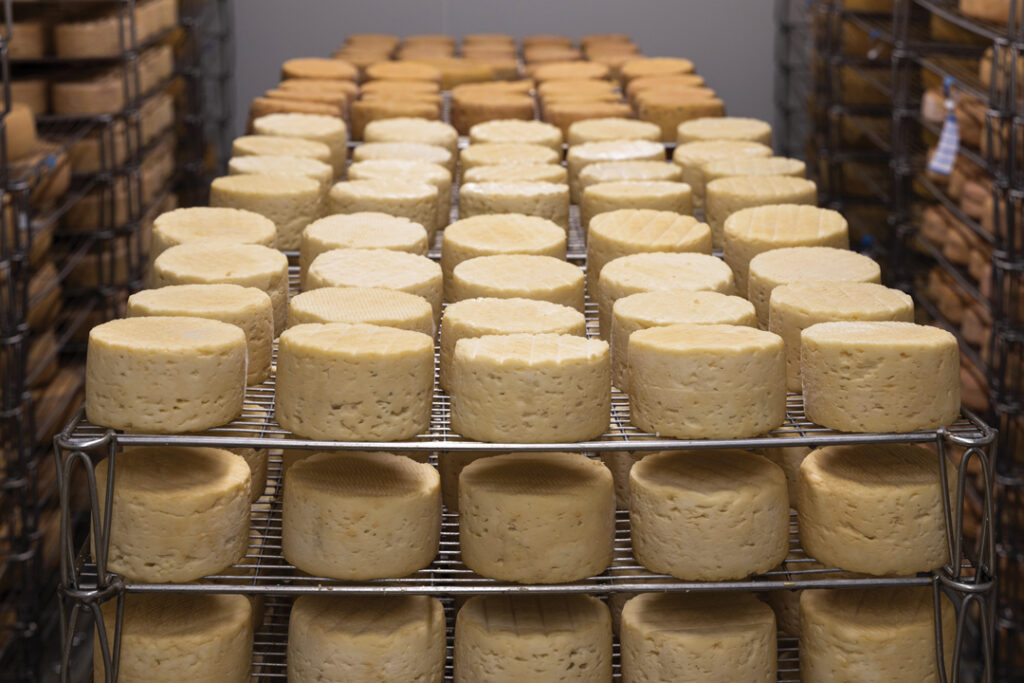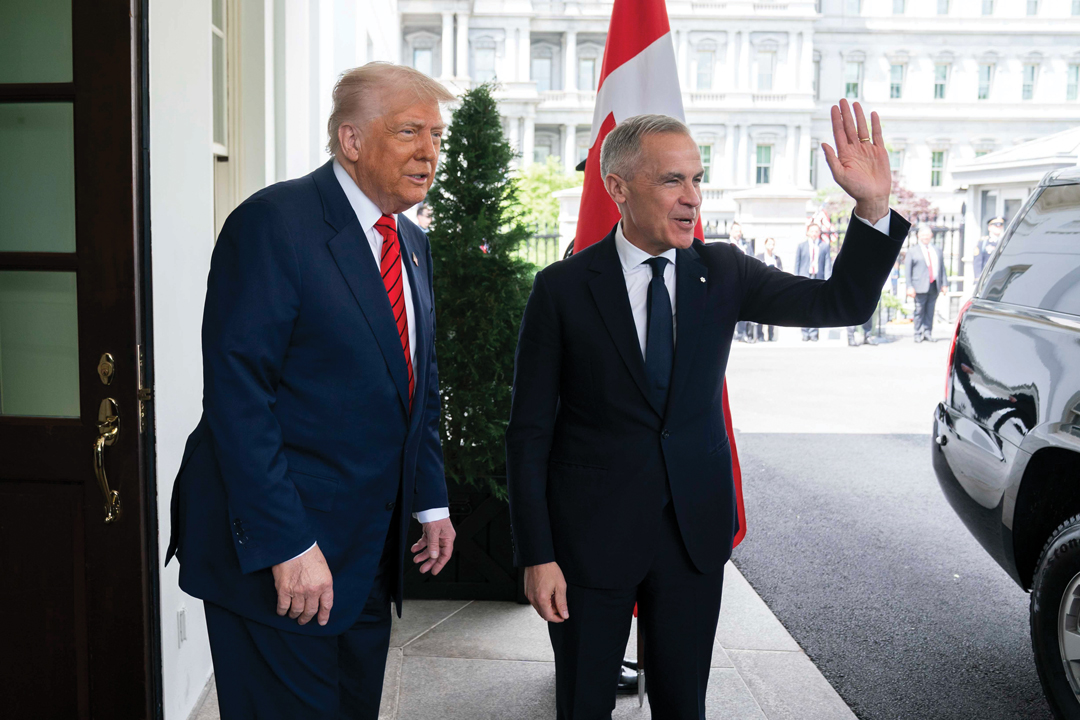TRADE WAR FALLOUT
BY TREVOR BACQUE • PHOTO BY LARS HAGBERG
The non-stop tariff talk has been dizzying to say the least. For those keeping score at home, U.S. President Donald Trump has publicly announced levies on Canada, but also on practically every major economy on earth. Numbers range from just a few percentage points to as much as 50 per cent. Recently, he secured a major deal with the EU for 15 per cent. Canada let its Aug. 1 deadline for a deal slip away. Now, the country is stuck paying a 35 per cent blanket tariff on all products not exempted under the CUSMA agreement, which is a short list of about five per cent of all Canadian products. Just as the month ended, the Americans also struck down duty-free de-minimis exemptions, which allowed the free shipment of goods under US$800, much to the detriment of many small Canadian businesses. Unrelated, but massively painful, a 75 per cent tariff on canola has been slapped on Canada by China over its concern dumping has diluted its domestic market.
On average, the U.S. tariff rate has increased to 18.3 per cent, a level not seen since the Great Depression. Brazil and India have seemingly taken the biggest hit at 50 per cent, though these two countries combined account for less than five per cent of goods imported by the U.S. Between April, when they went into effect on most countries that export goods to the U.S., and August, the Americans have secured more than $100 billion in tariff revenue.
All this massive uncertainty continues to cause headaches and constant guesswork for Canadian politicians and bureaucrats behind the scenes. One of the biggest fears talked about largely in whispers is uncertainty about the CUSMA agreement to be renegotiated in 2026. Yes, Canada must pay tariffs now on a small amount of goods, but the number of products exempted under CUSMA is staggering. What happens if they aren’t exempt?
Everyone has taken note of the fact that our once stable trade agreement with the U.S. has been upended, and that Canada needs a fresh trade strategy. To that end, RBC published a study this year, Food First: How agriculture can lead a new era for Canadian exports. The report’s key finding is that, with the right strategy, Canada could grow by 30 per cent of global market share and drive $44 billion in new agrifood investments come 2035.
The bank’s agricultural policy lead Lisa Ashton explained that Canada’s ag exports have quadrupled in value since 2000, yet the country’s market share has shrunk by 12 per cent in that same period. “With rising trade uncertainty and escalating tariffs in North America, Canada must accelerate efforts to diversify its trading partners, particularly in Southeast Asia, Africa and the Middle East,” she said.
Another aspect of the issue is Canada and the U.S. have fragile relations as competitors expand their reach. Upstart Brazil has gained ground in the Middle East and Africa while Canada’s traditional competitor Australia continues to make big inroads into Southeast Asia.
With about 60 per cent of Canada’s agrifood products going into the U.S., the report states our country is now “overly reliant” on our southern neighbour to buy what we produce. It also notes more than $100 billion worth of agriculture and agri-food products cross the border annually, with the U.S. importing nearly 60 per cent of this trade. One example is canola, which, in 2024, might as well have had the American flag on labels as 96 per cent of all oil and 65 per cent of meal exports were destined for that country.
The world’s largest unsecured border helps bring the two countries’ trading relationship closer than ever, but for many, it’s too much bread in one basket. Compared to our primary exporting competitors—Australia, Brazil, the Netherlands and the U.S.—we send 20 per cent more to America than our next competitor does to its biggest market (Brazil to China, about 35 per cent).
Since 2000, global export revenues topped $100 billion annually from $27 billion, yet the market cap decreased from 4.2 per cent to 3.7 per cent. RBC noted money left on the table from Canada’s cozy relationship with the U.S. combined with aggressive expansion by other countries has resulted in $23 billion in lost revenue potential.
The solution for all of this, RBC states, is threefold. Grow where Canada already enjoys market access, expand in the world’s best growth markets and maintain existing relationships through strengthened “food diplomacy.”
With 15 free trade agreements already in place, Canada has access to about two-thirds of the global economy, but clearly the country could do better for even greater profit and market share. The new growth markets flagged in the report are primarily located in Southeast and South Asia, two regions that are predicted to explode in both agricultural growth and exports over the next 10 years.
The report urges Canada to strengthen existing relationships with trusted buyers, namely China, Japan, Mexico and, still, America. The five keys to achieve these goals are: Innovation; Capital; Digital access; Export infrastructure; and, Global marketing.
Food First strikes an expectant tone to wrap up and backs the notion Canada is well positioned to make a big splash in the next decade with a few focused shifts for its agricultural production and export strategies. “Moving from short-term reactionary tactics to strategic growth, Canada can use the U.S. tariff threats as a wake-up call to leverage agriculture and agri-food as a driving force for trade diversification while building Canadian self-sufficiency,”
it states.

BOOTS ON THE GROUND
While Canada continues to temporarily walk on tariff-free eggshells under CUSMA, its U.S. trade relationship is fraught with peril. Michael Harvey is the executive director of the Canadian AgriFood Trade Alliance and said tensions continue to ratchet up. The only reprieve now is a glass ceiling for at least another year.
“The political risk factor has gone up for Canadian ag exporters over the last few months, but the tariffs haven’t been realized in that Canadian agri-food exports, since they’re CUSMA compliant, aren’t currently paying any tariffs to get into the U.S. market.” His members’ biggest concern is across the board tariffs, plain and simple. The next biggest risk factor is the CUSMA renegotiation.
Harvey is profoundly dissatisfied with how Prime Minister Mark Carney and his team have negotiated on the trade front to date. With Bill C-202, which automatically exempts supply management from any trade discussions whatsoever, Harvey doesn’t hold back. “We opposed it from the beginning because we thought it was absolutely terrible trade policy for Canada. So now, we’re very disappointed that the government decided to adopt a terrible trade policy for Canada,” said Harvey. “When you take things off the table, other countries will take things off the table, and we also think that it undermines our reputation as a free trading nation. When we carve out big sectors of the economy, we’re not interested in the rules-based system.”
Another large farm lobby, the Grain Growers of Canada, was equally critical when the legislation came to pass. “Despite the government’s stated commitment to expanding trade, Bill C-202 ties the hands of our negotiators at a critical time,” said Kyle Larkin, executive director of GGC. “It passed without consultation or debate—a deeply flawed process that ignored the farmers it most affects.”
Harvey said all that can be done now is to move forward and concentrate on freer trade and continue to try and adhere to a more rules-based international environment. He is convinced consumers will eventually tire of the constant tariff cat-and-mouse games, that should disproportionately affect American citizens, who will want more normalcy in their daily lives. How long that may take is anyone’s guess. “I think we’ll get back there, but we’re going through a phase right now where some of the biggest economies of the world are looking at things through another lens and that’s deeply unfortunate,” he said.
For those, though, who think a non-existent Canada–U.S. trade relationship is possible, Harvey dismisses the idea almost before the question is out. “Reality check; the United States is by far our most important market, and it’s next door,” he said bluntly. “We’ve got tremendous competitive advantages so you can’t make up for it through diversification, but diversification is a good in and of itself. There’s some big growth in the markets in places like the Indo-Pacific where there’s both population growth and the population is getting wealthier. There are very good things to do in other markets, but there’s no way that you can diversify away from the most important market.”
Upcoming mid-term elections along with virtually guaranteed inflation and higher food costs for Americans are likely to temper both the rhetoric and action of Trump’s tariff gambit. “I’ve got a certain amount of confidence that over time [the Trump administration] will come to realize that was a poor policy for them,” said Harvey. “I wouldn’t assume that any decisions that were made on tariffs were permanent in nature. The geographic realities of our two countries being next to each other and working together are more important than short-term political issues.”
The CUSMA agreement will be reviewed in July 2026. Any potential changes to the agreement and when they would come into effect would be subject to negotiation.
ELIMINATION OF LOCAL BARRIERS
One idea bandied about is that Canada could stimulate its economy with elimination of interprovincial trade barriers, long panned by multiple industries. Impediments are found at various stages of the agricultural supply chain; B.C. wine to Alberta being but one example. Provinces have varied trucking regulations in areas such as weight restrictions and safety requirements. With supply management, borders can be shut overnight to restrict movement as they limit production and set prices.
On the whole, these can limit Canada’s own domestic economic growth, cost the country billions of dollars and ultimately hinder growth, innovation and productivity. For consumers, it can be most easily seen in the form of reduced choice of goods, products and services.
The Canadian Free Trade Agreement has been in place for more than eight years, but it gives provinces considerable agency to protect their own interests. This has ultimately proven to be the country’s biggest single internal trade barrier.
A survey by the Confederation of Tomorrow showed that between 2019 and 2025, Canadian attitudes on interprovincial trade barriers are largely unchanged. In 2019, 23 per cent believed provincial governments should not be allowed to protect local businesses and keep out other provinces offering the same good or service. That number in 2025 was 22 per cent.
Quebec, which has the most provincial protections, has the largest support for blocking other provinces from coming in with goods and services at 37 per cent. Newfoundland and Labrador was the lowest at 20 per cent while Alberta sat at 25 per cent. Alberta and B.C. tied for first to say no regarding the ability for a province to favour local businesses and prevent businesses elsewhere in Canada selling the same product in their province at
27 per cent.

CANADIAN GOVERNMENT PRIORITIES
One of Canada’s top priorities for the foreseeable future appears to be the Indo-Pacific region. Global Affairs Canada has even produced its own Indo-Pacific strategy and in early 2024, it set up a new office and team in Manila to boost on-the-ground partnerships and increase face time to promote the high quality and sustainable production methods of Canadian food.
The federal government refused requests for an interview but did provide answers and commentary via email. “Through the [Manila office], Canada is amplifying its diversification efforts, advocating for science- and rules-based trade,” said Global Affairs Canada spokesman John Babcock. He added it also supports Canadian exporters as they increase their product volumes going abroad. “We are committed to working hand-in-hand with industry to diversify trade of Canada’s high-quality agriculture and agri-food products.”
On its website, the federal government notes the region will account for half the world’s GDP and two-thirds of its population by 2040. In just five years’ time, it adds, two-thirds of the world’s middle-class citizens will reside within the Indo-Pacific. With 27 countries included in this area, and $47.9 trillion in economic activity, it’s clear why Canada wants to export a greater slice of pie.
In August, rookie ag minister Heath MacDonald conducted a seven-day blitz of Indonesia, the Philippines and Singapore, accompanied by CEOs of virtually every major Canadian farm association to demonstrate the country means business. After the trip, which included meetings with each nation’s ag minister as well as ASEAN Secretary-General Kao Kim Hourn, MacDonald emphasized Canada’s commitment to the region.
“Our farmers and food processors work tirelessly to produce reliable, high-quality and safe food,” he said. “Because of the reputation they’ve helped build, more countries are choosing our products, and we’re absolutely focused on creating more opportunities for them by increasing and diversifying our exports, moving forward on new free trade agreements and raising the profile of the Canada brand worldwide, especially in areas like the Indo-Pacific.”
Opportunity also beckons threats. Many Indo-Pacific countries are locked in regional disputes and have long-standing civil unrest. The top country Canada will maintain a watchful eye on in all of these international trade expansions is China, which it labels an increasingly disruptive global power. This plan proclaims it won’t tolerate the Asian superpower’s underhanded tactics, no matter the scenario.
“In areas of profound disagreement, we will challenge China, including when it engages in coercive behaviour—economic or otherwise—ignores human rights obligations or undermines our national security interests and those of partners in the region,” reads the strategy. It adds China has long been a beneficiary of rules-based international order in the advancement of its own interests but now sees fit to reinterpret the rules to further benefit itself. Canada’s stance is that the rules must be respected to allow governments to solve shared problems.
To strengthen and deepen ties in the region, it produced five strategic goals: Promote peace, resilience and security; Expand trade, investment and supply chain resilience; Invest in and connect people; Build a sustainable and green future; and, Canada as an active and engaged partner to the Indo-Pacific.
The report ends on an optimistic note that arguably Canada’s No. 1 play lies due west. “Canada is looking out at the horizon of the Indo-Pacific future with a clear view of the shared prosperity that lies ahead for Canadians and for people throughout the Indo-Pacific region. By engaging and investing in partnership, we will secure a better future for all.”
In addition to not waiting around while the U.S. flip flops on tariffs, Carney issued a joint statement with EU leaders in June along with a 22-point manifesto to deepen ties to the EU that covers everything from defence to food.
At home, part of Carney’s Bill C-5, the Building Canada Act, is focused on nation building projects, which includes expansion at the Port of Montreal and doubling LNG production in Kitimat, B.C. The purpose of the Act is to enhance Canada’s prosperity, national security, economic security, defence and autonomy by ensuring projects that are in the national interest, according to the federal government, are completed. The crux of the entire Act, however, is to do everything very quickly.
At present, it appears Canada is trying to concurrently insulate itself from tariff pain and maintain already-exempted CUSMA goods with the same status. Time will tell if this is tangible or laughable.
“In the face of global trade challenges, including unwarranted tariffs from the United States, the Government of Canada remains committed to expanding and diversifying Canadian trade for resilient growth in the world economy of both today and tomorrow,” said Babcock.







Comments